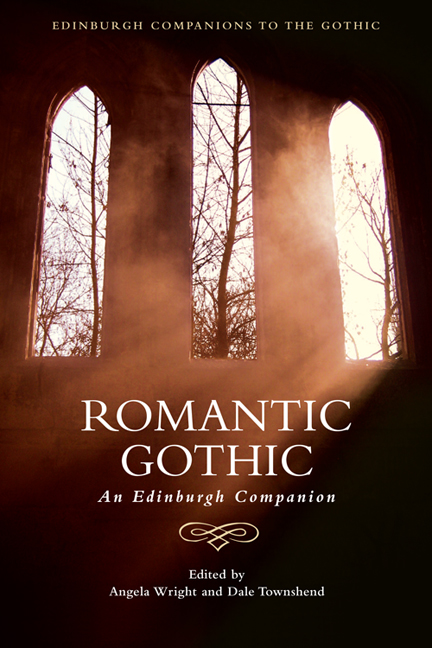Book contents
- Frontmatter
- Contents
- 1 Gothic and Romantic: An Historical Overview
- Part I Gothic Modes and Forms
- 2 Graveyard Writing and the Rise of the Gothic
- 3 Gothic Romance
- 4 The Gothic Stage: Visions of Instability, Performances of Anxiety
- 5 Gothic Poetry and First-Generation Romanticism
- 6 Gothic and Second-Generation Romanticism: Lord Byron, P. B. Shelley, John Polidori and Mary Shelley
- 7 Political Gothic Fiction
- 8 Shorter Gothic Fictions: Ballads and Chapbooks, Tales and Fragments
- 9 Oriental Gothic
- 10 Gothic Parody
- Part II National and International Borders
- Part III Reading the Romantic Gothic
- Notes on Contributors
- Index
3 - Gothic Romance
from Part I - Gothic Modes and Forms
Published online by Cambridge University Press: 05 August 2016
- Frontmatter
- Contents
- 1 Gothic and Romantic: An Historical Overview
- Part I Gothic Modes and Forms
- 2 Graveyard Writing and the Rise of the Gothic
- 3 Gothic Romance
- 4 The Gothic Stage: Visions of Instability, Performances of Anxiety
- 5 Gothic Poetry and First-Generation Romanticism
- 6 Gothic and Second-Generation Romanticism: Lord Byron, P. B. Shelley, John Polidori and Mary Shelley
- 7 Political Gothic Fiction
- 8 Shorter Gothic Fictions: Ballads and Chapbooks, Tales and Fragments
- 9 Oriental Gothic
- 10 Gothic Parody
- Part II National and International Borders
- Part III Reading the Romantic Gothic
- Notes on Contributors
- Index
Summary
Otranto's Spawn
Most accounts of the Gothic novel take Horace Walpole's The Castle of Otranto (1764) as the genre's point of origin. As with most generic boundaries – and stories of origin – there is an arbitrary element in the imposition of such a dividing line. Thomas Leland's Longsword, Earl of Salisbury (1762), for example, defined by its subtitle as a ‘Historical Romance’, has as good a claim to be situated within the genre as many later texts. Nevertheless, Walpole's contemporaries did understand his work as a starting point; satirising the boom in Gothic fiction-writing in the 1790s, T. J. Mathias lamented that ‘nought but ghosts and trinkets be display'd, / Since Walpole ply'd the virtuoso's trade’. Mathias later added a note that underlines Walpole's responsibility for the later texts: his ‘Otranto Ghosts have propagated their species with unequalled fecundity. The spawn is in every novel shop’ (Mathias 1798: 402). And what makes Otranto stand out as a progenitor, then and now, is that Walpole deliberately positioned his fiction as a new kind of writing.
Otranto may not actually be the first Gothic novel – certainly it was not the first work of fiction to contain what we might call Gothic elements – but it retains its significance because of its explicit, self-conscious revival of the ‘romance’ form, and its manipulation of that form into something conceived of as original. In the Preface to the novel's second edition, Walpole famously described Otranto as ‘an attempt to blend the two kinds of romance, the ancient and the modern’ (Walpole 2008: 9). His text thus presents itself as a new genre, one that merges the improbable tales of heroes and monsters found in chivalric romance with the stories of everyday life found in the modern novel:
In the former all was imagination and improbability; in the latter, nature is always intended to be, and sometimes has been, copied with success. Invention has not been wanting, but the great resources of fancy have been damned up … The author of the following pages thought it possible to reconcile the two kinds. (Walpole 2008: 9)
Walpole's understanding of the typology of his work in this formulation was in some ways as influential as the narrative itself.
- Type
- Chapter
- Information
- Romantic GothicAn Edinburgh Companion, pp. 55 - 72Publisher: Edinburgh University PressPrint publication year: 2015



